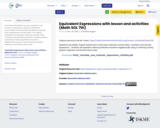
Identifying and applying transformations: translation, reflection, and rotation - Mathematics Instructional Plan
- Subject:
- Mathematics
- Material Type:
- Lesson Plan
- Provider:
- VDOE
- Author:
- VDOE
- Date Added:
- 10/07/2024

Identifying and applying transformations: translation, reflection, and rotation - Mathematics Instructional Plan

Translating and reflecting right triangles and rectangles on the coordinate plane - Mathematics Instructional Plan

Reflecting, Dilating, and Translating Functions - Mathematics Instructional Plan

Students will participate in a 5E lesson. To ENGAGE, students will connect their understanding of similarities between parent and offspring to the fundamental molecule of life: DNA. To EXPLORE, students will participate in interactives to observe, analyze and summarize how genes are used to create proteins and traits. In the EXPLAIN section, students will take notes on DNA replication and the Central Dogma. To ELABORATE on their understanding of DNA, students will participate in a protein synthesis race (game) to practice transcription and translation. Formative evaluations of students's ability to explain the process of protein synthesis include (1) a protein synthesis and codon practice sheet, (2) a labeling activity, and (3) making a recording that models and explain the process. As an extension, students can apply their understanding of mRNA to explain how the Pfizer and Moderna COVID-19 vaccines work. Finally, int summative EVALUATE, students model replication, transcription, and translation as they build an organism!

In this Illustrative Math resource, students must transform expressions using the distributive, commutative and associative properties to decide which expressions are equivalent. The Virginia Department of Education extension activity titled, "Translate and Evaluate Expressions" directs students to represent verbal quantitative situations algebraically using a matching activity, graphic organizer, and teacher lesson plan.

Just in Time Quick Check Transformations

Students use negative expressions to translate sentences from English to French.

Students review a few main rules for when and how to use the subjunctive, review a handful of common expressions that trigger subjunctive usage, and then work in partner groups to translate and diagram 12 sentences.

The mini lesson consists of a presentation of slides of transformations of translation, reflections, and rotations. Students will decide which slide and use a text box to type the answer per slide.

In this lesson, the students will explore and learn how to translate two step algebraic expressions from words and real-world scenarios. The teacher will engage students in discussion and facilitate their learning as they encounter a variety of learning styles including sorts, self-check games, and drag-and-drop modeling. The attached PDF provides links to the resources and materials.